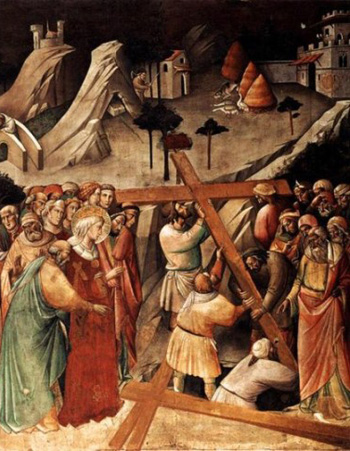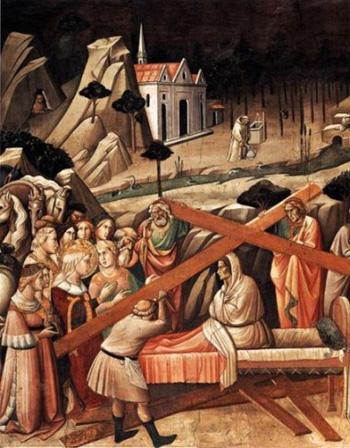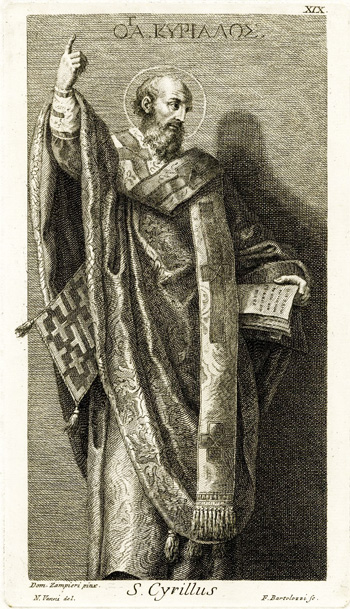Traditionalist Issues
 |
 |
 |
 |
 |
 |
 |
Dialogue Mass - LXXXVI
The Finding of the Holy Cross
We will now consider the removal of the feast of the Finding of the Holy Cross (May 3) from the General Roman Calendar in 1960. The True Cross – the historical Cross on which our Savior died – is, of course, the most highly prized of all relics because it was the instrument of salvation. Its value as a relic was recognized in the early 4th century when St. Helena, the mother of the Emperor Constantine, had a vision that inspired her to visit Jerusalem and find the site of the Crucifixion.

 The Second Nocturn in the traditional Roman Breviary for May 3 relates:
The Second Nocturn in the traditional Roman Breviary for May 3 relates:
“After that famous victory that the Emperor Constantine gained over Maxentius, in the year 312, on the eve of which the banner of the Cross of the Lord had been given to him from Heaven, Helena, the mother of Constantine, being warned in a dream, came to Jerusalem, in 326, to seek for the Cross. There it was her care to cause to be overthrown the marble statue of Venus, which had stood on Calvary for about 180 years, and which had originally been put there to desecrate and destroy the memorial of the sufferings of the Lord Christ.…
“Helena caused deep excavations to be made, which resulted in the discovery of three crosses, and, apart from them, the writing that had been nailed on that of the Lord. But which of the crosses had been His was unknown, and was only manifested by a miracle. Macarius, Bishop of Jerusalem, after offering solemn prayers to God, touched with each of the three a woman who was afflicted with a grievous disease. The first two had no effect, but at the touch of the third she was immediately healed.”
The Collect of the abolished Mass, moreover, confirms this miraculous power and attributes it specifically to the “glorious finding of the Cross of our salvation.” (1)
The Breviary continues:
“Helena, after she had found the life-giving Cross, built over the site of the Passion a Church of extraordinary splendor, wherein she deposited part of the Cross, enclosed in a silver case. Another part, which she gave to her son, Constantine, was laid up in the Church of the Holy Cross of Jerusalem, which he built at Rome on the site of the Sessorian Palace.”
The historicity of this discovery was accepted by the Church mainly on the testimony of St Cyril, Bishop of Jerusalem (c. 315-386). (2) Being a resident of the area from his childhood, he might even have seen the excavations and would almost certainly have heard about them. He later mentioned, with particular reference to the Cross, that “the Holy Places that had been hidden were revealed” during the reign of Constantine. (3)
In his Catechetical Lectures, St. Cyril made several references to “the wood of the Cross, which is seen here among us even to the present day.” And, preaching in 348 in the church founded by Constantine on the recently discovered site of the Crucifixion, he stated:
“There He was crucified for our sins. If you deny it, this place refutes you visibly – this blessed Golgotha, in which we are even now assembled for the sake of Him who was here attached to the Cross – as does the wood of the Cross, of which fragments without number have already been carried throughout the world.” (4)
St. Cyril’s testimony was considered authentic by the Church for several reasons. He was a man of great spiritual stature and personal integrity, and was one of the very few Bishops of the time who had courageously defended the Faith during the Arian heresy, suffering persecution from his brother Bishops.
Not only did he have detailed knowledge of the topography of the area, but he was also familiar with local events and contemporary reports. His references to the wood of the Cross were located in specific historical circumstances, and his knowledge of events was, therefore, rooted in factuality, not fanciful legend. Thus, we can be morally certain that the relics of the True Cross had been found in his lifetime and immediately received widespread veneration.
There is no reason to doubt the veracity of 4th century accounts of St. Helena or the veneration of fragments of the True Cross simply because they were first circulated by means of oral testimony. They were soon recorded in writing by people who lived in the same century.
Apart from St. Cyril, we have the written testimony of St. Ambrose (c. 340–397) who mentions how St. Helena went to Jerusalem and found the Holy Cross; (5) St. Paulinus, Bishop of Nola (354-431), who had acquired a fragment of the Cross from Jerusalem; St. John Chrysostom (349-407); the nun Egeria, who made a pilgrimage to the Holy Land in 380; and the historian Rufinus (c. 340-410).
A tragic farce
 Even though it was a feast of universal significance in the Church, having been celebrated in Rome from the 6th century (and earlier than that in the East), the progressivist reformers considered it had no place in the Universal Calendar. Their claim that the Finding of the Cross (May 3) was a duplication of the Exaltation of the Cross (September 14) – and that it should, therefore, be eliminated for the purposes of “simplification” – is demonstrably absurd. It is easily debunked by comparing the two feast days as they were handed down to us in the traditional Missal.
Even though it was a feast of universal significance in the Church, having been celebrated in Rome from the 6th century (and earlier than that in the East), the progressivist reformers considered it had no place in the Universal Calendar. Their claim that the Finding of the Cross (May 3) was a duplication of the Exaltation of the Cross (September 14) – and that it should, therefore, be eliminated for the purposes of “simplification” – is demonstrably absurd. It is easily debunked by comparing the two feast days as they were handed down to us in the traditional Missal.
It can be seen that we are not dealing with duplicated Masses, but with two very different liturgies. The Propers (Collect, Gospel, Offertory, Secret and Post-communion) of the Finding of the Cross differ completely from those of the Exaltation. Moreover, they contain phrases that are not found in the Exaltation, e.g. “miracula” (miracles); “bellorum nequitia” (the horrors of war); “ad conterendas potestatis adversae insídias (trample underfoot the snares of the enemy’s power); “ab hoste malígno defendas” (defend us from the craft of the Evil One).
The tragedy of this reform is that the theologically rich Propers of the Finding, emphasizing the Christian struggle against the forces of evil, were lost to the wider Church when the feast was suppressed. And that was done in 1960, even before Bugnini and the Consilium produced the Novus Ordo liturgy from which they eliminated or toned down suchlike references because they were “too negative” for modern man.
The two feasts also differ because these prayers reflect two distinct themes – first, the miraculous discovery and, then, the glorious triumph of the Holy Cross. The May feast commemorates the finding of the Cross in 326, and places particular emphasis on its significance as a relic; whereas the September feast celebrates two historical events – the dedication of Constantine’s Church of the Holy Sepulcher built on Golgotha in 335, and the restoration of the True Cross to Jerusalem in 629 after it had been stolen and temporarily lost to the Church. (6)
In short, without the initial finding of the Cross, there would be no factual justification for the feast of the Exaltation, which commemorates its subsequent loss, rediscovery and safe return to its homeland. Therefore, the September feast is dependent on the May feast for its meaning and historicity. It makes no sense to keep the one and abolish the other.
A transparent charade
It is now claimed that the feast of the Exaltation commemorates all themes rolled into one, so that no one should have cause for complaint at losing the Finding. But this is a classic piece of obfuscation, for the two liturgies, as they stood in 1960, each had its own theological raison d’être that determined its place in the Calendar.
Significantly, it was the Finding of the Cross that gave rise to its veneration, not just in Jerusalem, but in all parts of the Roman Empire where fragments of it were dispersed from 326 AD. It was only natural, therefore, that the Finding itself should be commemorated in a special feast day of its own, and have an honored place in the General Roman Calendar.
We must conclude that its suppression in 1960 was entirely unjustified, having been brought about under false pretenses. We do not need to look far for the real, underlying reason for the disappearance of this feast – “Ecumenism” – which we will examine in the next article.
Continued


Above, St. Helena finds the three crosses; below, the True Cross cures a sick woman

“After that famous victory that the Emperor Constantine gained over Maxentius, in the year 312, on the eve of which the banner of the Cross of the Lord had been given to him from Heaven, Helena, the mother of Constantine, being warned in a dream, came to Jerusalem, in 326, to seek for the Cross. There it was her care to cause to be overthrown the marble statue of Venus, which had stood on Calvary for about 180 years, and which had originally been put there to desecrate and destroy the memorial of the sufferings of the Lord Christ.…
“Helena caused deep excavations to be made, which resulted in the discovery of three crosses, and, apart from them, the writing that had been nailed on that of the Lord. But which of the crosses had been His was unknown, and was only manifested by a miracle. Macarius, Bishop of Jerusalem, after offering solemn prayers to God, touched with each of the three a woman who was afflicted with a grievous disease. The first two had no effect, but at the touch of the third she was immediately healed.”
The Collect of the abolished Mass, moreover, confirms this miraculous power and attributes it specifically to the “glorious finding of the Cross of our salvation.” (1)
The Breviary continues:
“Helena, after she had found the life-giving Cross, built over the site of the Passion a Church of extraordinary splendor, wherein she deposited part of the Cross, enclosed in a silver case. Another part, which she gave to her son, Constantine, was laid up in the Church of the Holy Cross of Jerusalem, which he built at Rome on the site of the Sessorian Palace.”
The historicity of this discovery was accepted by the Church mainly on the testimony of St Cyril, Bishop of Jerusalem (c. 315-386). (2) Being a resident of the area from his childhood, he might even have seen the excavations and would almost certainly have heard about them. He later mentioned, with particular reference to the Cross, that “the Holy Places that had been hidden were revealed” during the reign of Constantine. (3)
In his Catechetical Lectures, St. Cyril made several references to “the wood of the Cross, which is seen here among us even to the present day.” And, preaching in 348 in the church founded by Constantine on the recently discovered site of the Crucifixion, he stated:
“There He was crucified for our sins. If you deny it, this place refutes you visibly – this blessed Golgotha, in which we are even now assembled for the sake of Him who was here attached to the Cross – as does the wood of the Cross, of which fragments without number have already been carried throughout the world.” (4)
St. Cyril’s testimony was considered authentic by the Church for several reasons. He was a man of great spiritual stature and personal integrity, and was one of the very few Bishops of the time who had courageously defended the Faith during the Arian heresy, suffering persecution from his brother Bishops.
Not only did he have detailed knowledge of the topography of the area, but he was also familiar with local events and contemporary reports. His references to the wood of the Cross were located in specific historical circumstances, and his knowledge of events was, therefore, rooted in factuality, not fanciful legend. Thus, we can be morally certain that the relics of the True Cross had been found in his lifetime and immediately received widespread veneration.
There is no reason to doubt the veracity of 4th century accounts of St. Helena or the veneration of fragments of the True Cross simply because they were first circulated by means of oral testimony. They were soon recorded in writing by people who lived in the same century.
Apart from St. Cyril, we have the written testimony of St. Ambrose (c. 340–397) who mentions how St. Helena went to Jerusalem and found the Holy Cross; (5) St. Paulinus, Bishop of Nola (354-431), who had acquired a fragment of the Cross from Jerusalem; St. John Chrysostom (349-407); the nun Egeria, who made a pilgrimage to the Holy Land in 380; and the historian Rufinus (c. 340-410).
A tragic farce

The testimony of St. Cyril of Jerusalem confirms the historicity of the Finding of the Holy Cross
It can be seen that we are not dealing with duplicated Masses, but with two very different liturgies. The Propers (Collect, Gospel, Offertory, Secret and Post-communion) of the Finding of the Cross differ completely from those of the Exaltation. Moreover, they contain phrases that are not found in the Exaltation, e.g. “miracula” (miracles); “bellorum nequitia” (the horrors of war); “ad conterendas potestatis adversae insídias (trample underfoot the snares of the enemy’s power); “ab hoste malígno defendas” (defend us from the craft of the Evil One).
The tragedy of this reform is that the theologically rich Propers of the Finding, emphasizing the Christian struggle against the forces of evil, were lost to the wider Church when the feast was suppressed. And that was done in 1960, even before Bugnini and the Consilium produced the Novus Ordo liturgy from which they eliminated or toned down suchlike references because they were “too negative” for modern man.
The two feasts also differ because these prayers reflect two distinct themes – first, the miraculous discovery and, then, the glorious triumph of the Holy Cross. The May feast commemorates the finding of the Cross in 326, and places particular emphasis on its significance as a relic; whereas the September feast celebrates two historical events – the dedication of Constantine’s Church of the Holy Sepulcher built on Golgotha in 335, and the restoration of the True Cross to Jerusalem in 629 after it had been stolen and temporarily lost to the Church. (6)
In short, without the initial finding of the Cross, there would be no factual justification for the feast of the Exaltation, which commemorates its subsequent loss, rediscovery and safe return to its homeland. Therefore, the September feast is dependent on the May feast for its meaning and historicity. It makes no sense to keep the one and abolish the other.
A transparent charade
It is now claimed that the feast of the Exaltation commemorates all themes rolled into one, so that no one should have cause for complaint at losing the Finding. But this is a classic piece of obfuscation, for the two liturgies, as they stood in 1960, each had its own theological raison d’être that determined its place in the Calendar.
Significantly, it was the Finding of the Cross that gave rise to its veneration, not just in Jerusalem, but in all parts of the Roman Empire where fragments of it were dispersed from 326 AD. It was only natural, therefore, that the Finding itself should be commemorated in a special feast day of its own, and have an honored place in the General Roman Calendar.
We must conclude that its suppression in 1960 was entirely unjustified, having been brought about under false pretenses. We do not need to look far for the real, underlying reason for the disappearance of this feast – “Ecumenism” – which we will examine in the next article.
Continued
- Deus, qui in praeclara salutiferae Crucis Inventione, passionis tuae miracula suscitasti: concede ut vitalis ligni pretio, aeternae vitae suffragia consequamur. (O God, Who in the glorious Finding of the Cross of our salvation, didst renew the miracles of Thy Passion, grant that, by the price of that life-giving wood, we may obtain the privilege of eternal life).
- Confessor and Doctor of the Church.
- St. Cyril, Letter to Constantius, 351. The Emperor Constantius II was the son and successor of Constantine. In this letter, St. Cyril mentioned the phenomenon of the luminous cross that appeared in the sky above Golgotha and was seen by all the inhabitants of Jerusalem.
- Catechetical Lectures, Lecture 4, De Cruce.
- St. Ambrose, De obitu Theodosii (395) (Funeral Oration for the Emperor Theodosius).
- In 614, the Persian King Chosroes II conquered Jerusalem. Among the spoils of war that he took back with him to Persia was the relic of the True Cross, which had been kept in the Church of the Holy Sepulchre from the time of St Helena and Constantine.
At the Battle of Nineveh in 627, the Byzantine Emperor Heraclius defeated the Persian King, and brought back the True Cross to Jerusalem in 629, where it was placed in the Church of the Holy Sepulchre.

Posted June 5, 2019
______________________
______________________
 Volume I |
 Volume II |
 Volume III |
 Volume IV |
 Volume V |
 Volume VI |
 Volume VII |
 Volume VIII |
 Volume IX |
 Volume X |
 Volume XI |
 Special Edition |


